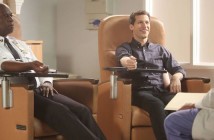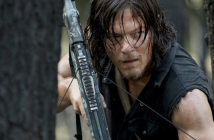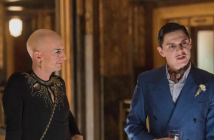October 31, 2015, 8:00 p.m. (EST), BBC
There’s something going very wrong with the world, and The Doctor has arrived to save it. That is, by and large, the premise of every Doctor Who story, even if the setting, time period, and threat changes week to week. The Doctor shows up, sees the problems plaguing the place he has arrived, and sets about solving them. “The Zygon Invasion” is the most obvious attempt at a “classic” story we have seen all season, not because it resembles Classic Who in structure or content, but because the whole thing is just pitched at the back row. It is self-consciously epic, with a globe-spanning narrative, a bombastic score, and a ready-made twist so delicious it made me say “holy shit!” out loud for the second time this season (for the record, I still think the “Under the Lake” cliffhanger is better, but the “Clara’s been a Zygon the whole time” twist is one that is so obvious and yet still so satisfying it stuns me).
The episode is fairly straight forward in its timeliness, basically setting this up as a metaphor for the Syrian civil war, with the radicalized Zygons standing in for ISIS and the majority of the Zygon population just wanting a safe place to live in peace, even as their status as outsiders and refugees poses a constant threat to them. This is a smart framework in which to do a story like this, and it also brilliantly starts us from a position Doctor Who doesn’t do often enough: the Zygons are not evil, there are just evil Zygons. Too often, this show becomes obsessed with the idea of entire races taking on the same basic personality traits in ways that are annoying, short-sighted, and smack of othering aliens in the Whoniverse in ways that are culturally and racially problematic. But occasionally (usually with the Silurians or the Ice Warriors, Who’s best complicated antagonists), the show seems to remember that every creature is a character, with their own internal life and their own reactions to the time and place from which they came. This episode emphasizes again and again that the villains are a radicalized element and do not stand for all of the Zygons.
Peter Harness, who previously penned last year’s brilliant “Kill the Moon,” is quickly establishing himself as not just one of the best current Doctor Who writers, but as the go-to for a form of story the modern era of the show has frequently eschewed. Harness is a blatantly political writer, taking on weighty and controversial topics from odd angles, to the point where rather than didactic, his episodes come across as thoughtful considerations of complex issues. The resolution of “Kill the Moon” could have turned it into a pro-life screed fairly easily, but Harness smartly centered the episode on a group of women, alone, making their own choices about their future. Similarly, parts of “The Zygon Invasion” smack of xenophobia, with the required assimilation of the Zygons as a condition of the treaty, but at this point I have enough faith in Harness to expect next week’s “The Zygon Inversion” to at least muddy the waters in terms of what he is trying to say here.
This episode is also compelling for the way it finally does a truly great Zygon story. It understands the paranoia that would set in for a soldier who is fighting an army of shape-shifting manipulators, the way it would be difficult to track the size of the army, the way the Zygons can infiltrate and undermine pretty much anything and anyone simply through the force of their ability to appear as the person you are least likely to actively attack. That scene on the church steps, in which a soldier is worn down by an obvious Zygon appearing as his mother, is absolutely thrilling and heartbreaking. It is basically the best version of “Zygons done right” the show has ever conjured, and when the episode is leaning in to the creeping horror of shape shifting enemies having thoroughly invaded our world, it is at its best.
Let’s talk about The Doctor for a moment, though. In series 9, Capaldi’s characterization has been way too focused on “cool,” in ways that are making me lose the thread on his performance a bit. The guitar playing has quickly grown old for me, and while I found the sonic sunglasses a fun bit of Doctor Who silliness upon their debut, I have a growing sense that they actually symbolize some of my problems with the current direction of this character. If The Doctor never refers to himself as “Doctor Disco” again, it will be way too soon. However, it is worth noting that Capaldi actually does some fairly incredible work in “The Zygon Invasion,” with the way he handles the UNIT troops in Turmezistan. He is not the standard “I hate soldiers” Doctor we saw a lot last season, but nor is he entirely the “let me hug the chaps with the guns” Doctor that his third incarnation frequently was. The Doctor understands the need for UNIT here and does not begrudge them their tasks. He does not argue against military force, but instead argues for a practical application thereof. He goes in as a man on a mission, a man who has been in situations like this before. He may not like the war he has walked into, but he knows how to comport himself in one, and he knows that he is a man of peace who can save lives, even if he also knows there will be death before the conflict ends. It’s brilliantly subtle work, and it almost makes up for some of Capaldi’s gurning at iconography earlier in the episode.
“The Zygon Invasion” is a traditional opener to a two-parter, largely consisting of set up and building action. The episode has problems, sure, but it also creates a fascinating threat that it approaches in a nuanced way. It is pitched a bit too bombastically from the word go to fully land for me, but it does enough things well for me to overlook its flaws with the hope that next week will stick the landing and make this a great two-parter and the exemplar of how to do the Zygons right. I have hope this won’t be another “Under the Lake”/”Before the Flood” situation (I don’t think “The Zygon Invasion” is as good as “Under the Lake,” and I seriously hope “The Zygon Inversion” isn’t as bad as “Before the Flood”), but this is basically a perfect example of a two-parter that is hard to review at the midpoint. A lot of good set up and a good cliffhanger make me think we may have our hands on something special once this story has finished next week.
The Roundup
- “Any race is capable of the best and the worst.” “Every race is peaceful, and warlike.”
- “You are very blobby. In fact, you two are the big blobs.”
- “Did you just call yourself Doctor Disco?”
- “You left us with an impossible situation, Doctor.” “Yes, I know. Its called peace.”
- “Do you still have the presidential aircraft?” “I thought you didn’t like being President of the world?” “No, but I like poncing about in the big plane.”
- “I’m the president of the world. I’m here to rescue people and generally establish happiness all over the place.”
- “Try to kill as few of them as possible. I need to have someone to negotiate with.”
- “It’s an odd world nowadays, isn’t it?” “It’s always been an odd world.”
- “Everybody middle-aged always thinks the world’s about to come to an end. It never does.”
“The Zygon Invasion” is a traditional opener to a two-parter, largely consisting of set up and building action.
-
GOOD




